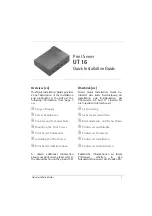
4R = quad-rank
xff
is the device organization (bit width)
x4 = x4 organization (4 DQ lines per SDRAM)
x8 = x8 organization
x16 = x16 organization
v
is the SDRAM and support component supply voltage (VDD)
Blank = 1.5 V specified
L = 1.35 V specified, 1.5 V operable
Note:
Values for these voltages are ‘specified’ which means the device
characteristics such as timing are supported at this voltage.
Values are ‘operable’ which means that the devices can be
operated safely at this voltage. However, device characteristics
such as timing may not be guaranteed. All devices must be
‘tolerant’ of the highest DDR3 nominal voltage of 1.5 V, meaning
that they may not operate at 1.5 V but may be powered at that
voltage without damage to the devices.
wwwww
is the DIMM bandwidth, in MBps
6400 = 6.40 GBps (DDR3-800 SDRAMs, 8-byte primary data bus)
8500 = 8.53 GBps (DDR3-1066 SDRAMs, 8-byte primary data bus)
10600 = 10.66 GBps (DDR3-1333 SDRAMs, 8-byte primary data bus)
12800 = 12.80 GBps (DDR3-1600 SDRAMs, 8-byte primary data bus)
14900 = 14.93 GBps (DDR3-1866 SDRAMs, 8-byte primary data bus)
m
is the DIMM type
E = Unbuffered DIMM (UDIMM) with ECC (x72-bit module data bus)
R = Registered DIMM (RDIMM)
U = Unbuffered DIMM with no ECC (x64-bit primary data bus)
aa
is the CAS latency, in clocks at maximum operating frequency
bb
is the JEDEC SPD Revision Encoding and Additions level
cc
is the reference design file for the design of the DIMM
d
is the revision number of the reference design of the DIMM
Note:
To determine the type of a DIMM, see the label on the DIMM. The
information on the label is in the format xxxxx nRxxx PC3v-xxxxxx-xx-xx-
xxx. The numeral in the sixth numerical position indicates whether the
DIMM is single-rank (n=1), dual-rank (n=2), or quad-rank (n=4).
v
The following rules apply to DDR3 DIMM speed as it relates to the number of
DIMMs in a channel:
– When you install 1 DIMM per channel, the memory runs at 1333 MHz
– When you install 2 DIMMs per channel, the memory runs at 1066 MHz
– When you install 3 DIMMs per channel, the memory runs at 800 MHz
– All channels in a server run at the fastest common frequency
– Do not install registered, unbuffered, and load reduction DIMMs in the same
server
v
The maximum memory speed is determined by the combination of the
microprocessor, DIMM speed, and the number of DIMMs installed in each
channel.
v
The server supports a maximum of 8 dual-rank RDIMMs. The server does not
support three quad-rank RDIMMs in the same channel.
Chapter 3. Installing optional devices
31
Summary of Contents for iDataPlex dx360 M4
Page 1: ...System x iDataPlex dx360 M4 Types 7918 and 7919 User s Guide...
Page 2: ......
Page 3: ...System x iDataPlex dx360 M4 Types 7918 and 7919 User s Guide...
Page 15: ...CAUTION Hazardous moving parts are nearby Safety xiii...
Page 16: ...xiv System x iDataPlex dx360 M4 Types 7918 and 7919 User s Guide...
Page 28: ...12 System x iDataPlex dx360 M4 Types 7918 and 7919 User s Guide...
Page 80: ...64 System x iDataPlex dx360 M4 Types 7918 and 7919 User s Guide...
Page 85: ......
Page 86: ...Part Number 90Y5668 Printed in USA 1P P N 90Y5668...
















































